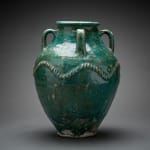Turquoise Glazed Jar, 3rd Century CE - 7th Century CE
Glazed Earthenware
31.5 x 23.9 cm
12 3/8 x 9 3/8 in
12 3/8 x 9 3/8 in
JB.1081
The Parthians, formerly a central Asian nomadic tribe, upon defeating the Seleucids towards the end of the 3rd century BC , went on to find a vast empire that stretched...
The Parthians, formerly a central Asian nomadic tribe, upon defeating the Seleucids towards the end of the 3rd century BC , went on to find a vast empire that stretched from the Mediterranean to the Indus. This empire, located on the Silk Road trade route between the Roman Empire and the Han Empire of China, flourished through the control of caravan cities along the Silk Route and became a center of trade and commerce. In contrast to their fiercely hostile relationship to Rome, the Parthians seem to have had thriving commercial relations to the Chinese Han Dynasty.
As early as the 2nd century BC the Chinese explorer Zhang Qian visited Parthia and described it as an advanced urban civilisation. Embassies were sent in both directions and trade flourished. Although the shapes of the vessels reveal a reliance on previous Greek and Anatolian forms, glazed turquoise/green ceramic vessels are one of the most distinctive Parthian legacies in pottery. Glazed ceramics were extremely rare in the Middle East prior to the Islamic period. At this early date the only glazed wares known were exclussively coming from China, possibly encouraged by diplomatic and trading ties in the Parthian lands. Despite their dazzling beauty these wares were used for purely practical purposes such as the storage and transportation of liquids and grains. Their colour was achieved by mixing copper and iron oxides to an alkaline glaze. This was subsequently applied on top of a fine white paste so that the reddish surface of the clay would not show through.
It has been suggested that in regards to the colour and the form, there is some obvious attempt to imitate metallic vessels, which were undoubtedly more costly. The green glaze has been likened to the patina acquired by bronze over time and some of the decorative elements have also been compared to twisted metal.
Buff earthenware jar coated with green lead glaze and decorated by appliqué rope-like ornament. Large ovoid body resting on a low foot-ring, with short waisted cylindrical neck; four square-section handles connect the neck to the wide sloping shoulder; everted slightly projecting flattened rim; the flange is an indication that our jar may originally had a cover. The meandering rope-like band in relief which runs below the shoulder is perhaps imitating metallic prototypes. This jar is exceptional for its size and quality of the glaze. The tone of the turquoise becomes lighter towards the base and the surface has a wonderful iridescent glow.
Iran, Sasano/Islamic, 7th or 8th century.
As early as the 2nd century BC the Chinese explorer Zhang Qian visited Parthia and described it as an advanced urban civilisation. Embassies were sent in both directions and trade flourished. Although the shapes of the vessels reveal a reliance on previous Greek and Anatolian forms, glazed turquoise/green ceramic vessels are one of the most distinctive Parthian legacies in pottery. Glazed ceramics were extremely rare in the Middle East prior to the Islamic period. At this early date the only glazed wares known were exclussively coming from China, possibly encouraged by diplomatic and trading ties in the Parthian lands. Despite their dazzling beauty these wares were used for purely practical purposes such as the storage and transportation of liquids and grains. Their colour was achieved by mixing copper and iron oxides to an alkaline glaze. This was subsequently applied on top of a fine white paste so that the reddish surface of the clay would not show through.
It has been suggested that in regards to the colour and the form, there is some obvious attempt to imitate metallic vessels, which were undoubtedly more costly. The green glaze has been likened to the patina acquired by bronze over time and some of the decorative elements have also been compared to twisted metal.
Buff earthenware jar coated with green lead glaze and decorated by appliqué rope-like ornament. Large ovoid body resting on a low foot-ring, with short waisted cylindrical neck; four square-section handles connect the neck to the wide sloping shoulder; everted slightly projecting flattened rim; the flange is an indication that our jar may originally had a cover. The meandering rope-like band in relief which runs below the shoulder is perhaps imitating metallic prototypes. This jar is exceptional for its size and quality of the glaze. The tone of the turquoise becomes lighter towards the base and the surface has a wonderful iridescent glow.
Iran, Sasano/Islamic, 7th or 8th century.



